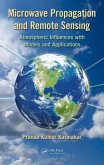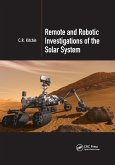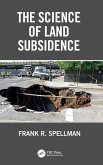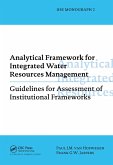Remote Sensing for Geophysicists
Herausgeber: Gupta, Mukesh
Remote Sensing for Geophysicists
Herausgeber: Gupta, Mukesh
- Gebundenes Buch
- Merkliste
- Auf die Merkliste
- Bewerten Bewerten
- Teilen
- Produkt teilen
- Produkterinnerung
- Produkterinnerung
This book aims to integrate exploration geophysics with remote sensing as a cost-effective method and easy to implement for prospecting in different areas. It provides exploration geophysicists with the necessary information on how to use advanced remote sensing technology in the exploration of oil and gas, minerals, and groundwater.
Andere Kunden interessierten sich auch für
![Ground-Based Microwave Radiometry and Remote Sensing Ground-Based Microwave Radiometry and Remote Sensing]() Pranab Kumar KarmakarGround-Based Microwave Radiometry and Remote Sensing236,99 €
Pranab Kumar KarmakarGround-Based Microwave Radiometry and Remote Sensing236,99 €![Microwave Propagation and Remote Sensing Microwave Propagation and Remote Sensing]() Pranab Kumar KarmakarMicrowave Propagation and Remote Sensing232,99 €
Pranab Kumar KarmakarMicrowave Propagation and Remote Sensing232,99 €![Remote and Robotic Investigations of the Solar System Remote and Robotic Investigations of the Solar System]() C. R. KitchinRemote and Robotic Investigations of the Solar System60,99 €
C. R. KitchinRemote and Robotic Investigations of the Solar System60,99 €![Remote Power Generating Systems with Using Low Frequency Transmission Remote Power Generating Systems with Using Low Frequency Transmission]() Mohammad Ali AdelianRemote Power Generating Systems with Using Low Frequency Transmission24,99 €
Mohammad Ali AdelianRemote Power Generating Systems with Using Low Frequency Transmission24,99 €![Generazione di Energia da fonti rinnovabili in regioni remote Generazione di Energia da fonti rinnovabili in regioni remote]() Paolo FilippucciGenerazione di Energia da fonti rinnovabili in regioni remote45,99 €
Paolo FilippucciGenerazione di Energia da fonti rinnovabili in regioni remote45,99 €![The Science of Land Subsidence The Science of Land Subsidence]() Frank R. SpellmanThe Science of Land Subsidence109,99 €
Frank R. SpellmanThe Science of Land Subsidence109,99 €![Analytical Framework for Integrated Water Resources Management Analytical Framework for Integrated Water Resources Management]() Paul van HofwegenAnalytical Framework for Integrated Water Resources Management65,99 €
Paul van HofwegenAnalytical Framework for Integrated Water Resources Management65,99 €-
-
-
This book aims to integrate exploration geophysics with remote sensing as a cost-effective method and easy to implement for prospecting in different areas. It provides exploration geophysicists with the necessary information on how to use advanced remote sensing technology in the exploration of oil and gas, minerals, and groundwater.
Produktdetails
- Produktdetails
- Verlag: CRC Press
- Seitenzahl: 526
- Erscheinungstermin: 4. März 2025
- Englisch
- Abmessung: 260mm x 183mm x 33mm
- Gewicht: 1173g
- ISBN-13: 9781032778921
- ISBN-10: 103277892X
- Artikelnr.: 71743688
- Herstellerkennzeichnung
- Libri GmbH
- Europaallee 1
- 36244 Bad Hersfeld
- gpsr@libri.de
- Verlag: CRC Press
- Seitenzahl: 526
- Erscheinungstermin: 4. März 2025
- Englisch
- Abmessung: 260mm x 183mm x 33mm
- Gewicht: 1173g
- ISBN-13: 9781032778921
- ISBN-10: 103277892X
- Artikelnr.: 71743688
- Herstellerkennzeichnung
- Libri GmbH
- Europaallee 1
- 36244 Bad Hersfeld
- gpsr@libri.de
Dr. Mukesh Gupta is a geophysicist and a professional researcher in coastal engineering at the Université du Québec à Rimouski (UQAR), Canada. He held a post-doctoral fellowship at the UCLouvain, Belgium in Arctic climate modeling, and conducted his research in developing satellite data products at the ICM-CSIC, Spain. He has been the NSERC Visiting Fellow at the Environment and Climate Change Canada, and a Scientist/Engineer at the SAC-ISRO, India with expertise in Earth observation. He earned his M.Tech. at the IIT Roorkee, India, and his Ph.D. at the University of Manitoba, Canada, specializing in applied geophysics and Arctic sea ice, respectively. Dr. Gupta is a Review Editor of over 30 journals and has peer-reviewed over 140 journal papers. He has published several peer-reviewed journal papers, scientific reports, and book chapters.
Section 1: Remote Sensing in Gravity Methods. 1. Satellite Gravimetry for
Geophysical Purposes. 2. Assimilating GRACE Data into a Hydrological Model.
3. Satellite-Based Geodesy. 4. A Brief History of GIA Research and Recent
Advances via Remote Sensing. Section 2: Remote Sensing in Magnetic Methods
. 5. Understanding Geomagnetic Environment from Satellite and Ground-Based
Magnetometers. 6. Mineral Exploration Using Remote Sensing. 7. Monitoring
Earth's Ionosphere using Remote Sensing Techniques. Section 3: Remote
Sensing in Seismic Methods. 8. Using Remote Sensing for Seismic
Interpretation: A Case Study from Coastal Tanzanian Basin. 9. Remote
Sensing for Studying Pre-Earthquake Phenomena. 10. Remote Sensing for
Neotectonic Investigations: A Case Study from Southern Egypt. Section 4:
Remote Sensing in Electrical Methods. 11. Integrated Approaches to
Groundwater Exploration: A Case Study of Maze Catchment, Ethiopia. 12.
Mineral Mapping Using Geoelectrics and Remote Sensing. 13. Satellite-Based
Investigations of Ionospheric Electric Fields. Section 5: Remote Sensing in
Electromagnetic Methods. 14. Remote Sensing Assessment of Accumulation Area
Ratio in Glacier Monitoring. 15. Remotely Piloted Aircraft Systems (RPAS)
in Geophysics. 16. Electromagnetic Methods in Biogeophysics. 17. Remote
Sensing Methods in Agrogeophysical Investigations. 18. Remote Sensing in
Coastal Studies. Section 6: Remote Sensing in Radioactivity Methods. 19.
Mineral Identification using Remote Sensing. 20. Remote Sensing Detection
of Marine Radioactivity. Section 7: Remote Sensing in Geophysical
Well-Logging. 21. Remote Sensing for Hydrocarbon Exploration. 22. Role of
Remote Sensing in Groundwater Well-Logging. Section 8: Remote Sensing in
Geothermics. 23. Remote Sensing in Geothermal Studies of Cold Regions. 24.
Heat Flow Terrestrial Mapping in Antarctica. 25. Geothermal Studies of
Volcanoes Using Satellites. 26. Using Remote Sensing for Geothermal
Exploration. Section 9: Remote Sensing in Integrated Geophysical Problems.
27. Leveraging Remote Sensing Technologies for Seismic Hazards Assessments.
28. Remote Sensing in Archeology. 29. Volcano Monitoring: Using SAR
Interferometry for the Pre-Unrest of La Palma and the Post-Unrest of
Santorini. 30. Mineral Exploration: Integrating Remote Sensing, GIS, AI,
and Seismic Methods. 31. Soil Textures and Urban Heat: Cooling Planning
Strategies. 32. Remote Sensing Technologies for Earthquake Management.
Geophysical Purposes. 2. Assimilating GRACE Data into a Hydrological Model.
3. Satellite-Based Geodesy. 4. A Brief History of GIA Research and Recent
Advances via Remote Sensing. Section 2: Remote Sensing in Magnetic Methods
. 5. Understanding Geomagnetic Environment from Satellite and Ground-Based
Magnetometers. 6. Mineral Exploration Using Remote Sensing. 7. Monitoring
Earth's Ionosphere using Remote Sensing Techniques. Section 3: Remote
Sensing in Seismic Methods. 8. Using Remote Sensing for Seismic
Interpretation: A Case Study from Coastal Tanzanian Basin. 9. Remote
Sensing for Studying Pre-Earthquake Phenomena. 10. Remote Sensing for
Neotectonic Investigations: A Case Study from Southern Egypt. Section 4:
Remote Sensing in Electrical Methods. 11. Integrated Approaches to
Groundwater Exploration: A Case Study of Maze Catchment, Ethiopia. 12.
Mineral Mapping Using Geoelectrics and Remote Sensing. 13. Satellite-Based
Investigations of Ionospheric Electric Fields. Section 5: Remote Sensing in
Electromagnetic Methods. 14. Remote Sensing Assessment of Accumulation Area
Ratio in Glacier Monitoring. 15. Remotely Piloted Aircraft Systems (RPAS)
in Geophysics. 16. Electromagnetic Methods in Biogeophysics. 17. Remote
Sensing Methods in Agrogeophysical Investigations. 18. Remote Sensing in
Coastal Studies. Section 6: Remote Sensing in Radioactivity Methods. 19.
Mineral Identification using Remote Sensing. 20. Remote Sensing Detection
of Marine Radioactivity. Section 7: Remote Sensing in Geophysical
Well-Logging. 21. Remote Sensing for Hydrocarbon Exploration. 22. Role of
Remote Sensing in Groundwater Well-Logging. Section 8: Remote Sensing in
Geothermics. 23. Remote Sensing in Geothermal Studies of Cold Regions. 24.
Heat Flow Terrestrial Mapping in Antarctica. 25. Geothermal Studies of
Volcanoes Using Satellites. 26. Using Remote Sensing for Geothermal
Exploration. Section 9: Remote Sensing in Integrated Geophysical Problems.
27. Leveraging Remote Sensing Technologies for Seismic Hazards Assessments.
28. Remote Sensing in Archeology. 29. Volcano Monitoring: Using SAR
Interferometry for the Pre-Unrest of La Palma and the Post-Unrest of
Santorini. 30. Mineral Exploration: Integrating Remote Sensing, GIS, AI,
and Seismic Methods. 31. Soil Textures and Urban Heat: Cooling Planning
Strategies. 32. Remote Sensing Technologies for Earthquake Management.
Section 1: Remote Sensing in Gravity Methods. 1. Satellite Gravimetry for
Geophysical Purposes. 2. Assimilating GRACE Data into a Hydrological Model.
3. Satellite-Based Geodesy. 4. A Brief History of GIA Research and Recent
Advances via Remote Sensing. Section 2: Remote Sensing in Magnetic Methods
. 5. Understanding Geomagnetic Environment from Satellite and Ground-Based
Magnetometers. 6. Mineral Exploration Using Remote Sensing. 7. Monitoring
Earth's Ionosphere using Remote Sensing Techniques. Section 3: Remote
Sensing in Seismic Methods. 8. Using Remote Sensing for Seismic
Interpretation: A Case Study from Coastal Tanzanian Basin. 9. Remote
Sensing for Studying Pre-Earthquake Phenomena. 10. Remote Sensing for
Neotectonic Investigations: A Case Study from Southern Egypt. Section 4:
Remote Sensing in Electrical Methods. 11. Integrated Approaches to
Groundwater Exploration: A Case Study of Maze Catchment, Ethiopia. 12.
Mineral Mapping Using Geoelectrics and Remote Sensing. 13. Satellite-Based
Investigations of Ionospheric Electric Fields. Section 5: Remote Sensing in
Electromagnetic Methods. 14. Remote Sensing Assessment of Accumulation Area
Ratio in Glacier Monitoring. 15. Remotely Piloted Aircraft Systems (RPAS)
in Geophysics. 16. Electromagnetic Methods in Biogeophysics. 17. Remote
Sensing Methods in Agrogeophysical Investigations. 18. Remote Sensing in
Coastal Studies. Section 6: Remote Sensing in Radioactivity Methods. 19.
Mineral Identification using Remote Sensing. 20. Remote Sensing Detection
of Marine Radioactivity. Section 7: Remote Sensing in Geophysical
Well-Logging. 21. Remote Sensing for Hydrocarbon Exploration. 22. Role of
Remote Sensing in Groundwater Well-Logging. Section 8: Remote Sensing in
Geothermics. 23. Remote Sensing in Geothermal Studies of Cold Regions. 24.
Heat Flow Terrestrial Mapping in Antarctica. 25. Geothermal Studies of
Volcanoes Using Satellites. 26. Using Remote Sensing for Geothermal
Exploration. Section 9: Remote Sensing in Integrated Geophysical Problems.
27. Leveraging Remote Sensing Technologies for Seismic Hazards Assessments.
28. Remote Sensing in Archeology. 29. Volcano Monitoring: Using SAR
Interferometry for the Pre-Unrest of La Palma and the Post-Unrest of
Santorini. 30. Mineral Exploration: Integrating Remote Sensing, GIS, AI,
and Seismic Methods. 31. Soil Textures and Urban Heat: Cooling Planning
Strategies. 32. Remote Sensing Technologies for Earthquake Management.
Geophysical Purposes. 2. Assimilating GRACE Data into a Hydrological Model.
3. Satellite-Based Geodesy. 4. A Brief History of GIA Research and Recent
Advances via Remote Sensing. Section 2: Remote Sensing in Magnetic Methods
. 5. Understanding Geomagnetic Environment from Satellite and Ground-Based
Magnetometers. 6. Mineral Exploration Using Remote Sensing. 7. Monitoring
Earth's Ionosphere using Remote Sensing Techniques. Section 3: Remote
Sensing in Seismic Methods. 8. Using Remote Sensing for Seismic
Interpretation: A Case Study from Coastal Tanzanian Basin. 9. Remote
Sensing for Studying Pre-Earthquake Phenomena. 10. Remote Sensing for
Neotectonic Investigations: A Case Study from Southern Egypt. Section 4:
Remote Sensing in Electrical Methods. 11. Integrated Approaches to
Groundwater Exploration: A Case Study of Maze Catchment, Ethiopia. 12.
Mineral Mapping Using Geoelectrics and Remote Sensing. 13. Satellite-Based
Investigations of Ionospheric Electric Fields. Section 5: Remote Sensing in
Electromagnetic Methods. 14. Remote Sensing Assessment of Accumulation Area
Ratio in Glacier Monitoring. 15. Remotely Piloted Aircraft Systems (RPAS)
in Geophysics. 16. Electromagnetic Methods in Biogeophysics. 17. Remote
Sensing Methods in Agrogeophysical Investigations. 18. Remote Sensing in
Coastal Studies. Section 6: Remote Sensing in Radioactivity Methods. 19.
Mineral Identification using Remote Sensing. 20. Remote Sensing Detection
of Marine Radioactivity. Section 7: Remote Sensing in Geophysical
Well-Logging. 21. Remote Sensing for Hydrocarbon Exploration. 22. Role of
Remote Sensing in Groundwater Well-Logging. Section 8: Remote Sensing in
Geothermics. 23. Remote Sensing in Geothermal Studies of Cold Regions. 24.
Heat Flow Terrestrial Mapping in Antarctica. 25. Geothermal Studies of
Volcanoes Using Satellites. 26. Using Remote Sensing for Geothermal
Exploration. Section 9: Remote Sensing in Integrated Geophysical Problems.
27. Leveraging Remote Sensing Technologies for Seismic Hazards Assessments.
28. Remote Sensing in Archeology. 29. Volcano Monitoring: Using SAR
Interferometry for the Pre-Unrest of La Palma and the Post-Unrest of
Santorini. 30. Mineral Exploration: Integrating Remote Sensing, GIS, AI,
and Seismic Methods. 31. Soil Textures and Urban Heat: Cooling Planning
Strategies. 32. Remote Sensing Technologies for Earthquake Management.









